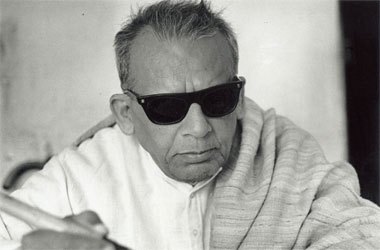
A recipient of Padma Vibhushan, Binod Bihari Mukherjee was an artist with diverse interests. His creativity was so intense that it found its way of expression not only in form of paintings but he also murals and sculptures.
Born in a highly literate family, Binod was unable to pursue a systematic form of schooling when an early childhood illness affected his vision. However, his own interest and talent for art and literature was soon recognized and he spent most of his former years of learning at Shanti Niketan, a world-renowned university for art and literature.
Binod’s style of work was simple and ideological. In his work, he renounced overt symbolism of mythological descriptions. Instead he turned to simple representations of his immediate surroundings.

Binod’s perception of the landscape of Shanti Niketan and the life within the campus has been very artistically represented by him in the form of compositional calligraphic paintings. His expression through his drawings and sketches, are full of life. Soon, he diversified his form of expression to mural paintings. Murals, he felt were more intricate and descriptive, inspiring him to present his vision of the world more comprehensively.
The first of his more significant murals is the representation of the local landscape he painted on the ceiling of the hostel dormitory of Shanti Niketan in the year 1940. In this mural he gathers his experience of the local villages in a continuous web of intricate images and unfolds it around the central pond to the four corners of the ceiling, constantly shifting the perspective and focus of the viewer.
Binod travelled widely to capture the various forms of nature into his work. He accepted the position of a Curator at the Nepal Government museum in Kathmandu. During his short stay in Nepal, he understood and captured Nepal’s rich art and craft heritage in a series of drawings and watercolours, adding a new dimension to his work.

